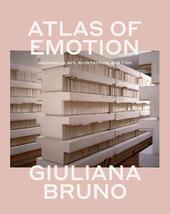
|
Atlas of Emotion: Journeys in Art, Architecture, and Film
Paperback / softback
Main Details
| Title |
Atlas of Emotion: Journeys in Art, Architecture, and Film
|
| Authors and Contributors |
By (author) Giuliana Bruno
|
| Physical Properties |
| Format:Paperback / softback | | Pages:496 | | Dimensions(mm): Height 256,Width 203 |
|
| Category/Genre | Theory of art
Theory of architecture
Film theory and criticism |
|---|
| ISBN/Barcode |
9781786633224
|
| Classifications | Dewey:700.9 |
|---|
| Audience | |
|---|
| Illustrations |
16 colour; 200+ B/W
|
|
Publishing Details |
| Publisher |
Verso Books
|
| Imprint |
Verso Books
|
| Publication Date |
10 July 2018 |
| Publication Country |
United Kingdom
|
Description
Atlas of Emotion is a highly original endeavour to map a cultural history of spatio-visual arts. In an evocative montage of words and pictures, emphasises that "sight" and "site" but also "motion" and "emotion" are irrevocably connected. In so doing, Giuliana Bruno touches on the art of Gerhard Richter and Annette Message, the film making of Peter Greenaway and Michelangelo Antonioni, the origins of the movie palace and its precursors, and her own journeys to her native Naples. Visually luscious and daring in conception, Bruno opens new vistas and understandings at every turn.
Author Biography
Giuliana Bruno is Emmet Blakeney Gleason Professor of Visual and Environmental Studies at Harvard University. She is the author of Streetwalking on a Ruined Map, winner of the 1993 Katherine Singer Kovacs prize for the best book in film studies, Public Intimacy and Surface.
ReviewsOne of those critical works packed with learning and insights that at the same time takes you on an exhilarating ride through its author's imagination. -- Marina Warner * Guardian * In this astonishingly provocative, captivating, tender, elegant, and passionate nonchronological, interdisciplinary book, Bruno connects splendidly a psychogeography of cultural life. . . She takes the readers through a poetico-scholarly and picturesque journey-a visual travelogue, based both on philosophical theories and erudite conjectures. . . . Bruno writes like an expressionist painter, who deeply captures the invisible and the instantaneous. * Choice *
|